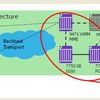By Mae Kowalke, TMCnet Contributor
As broadband traffic continues to increase, it is increasingly becoming a challenge to scale power management accordingly to keep power consumption down and heat dissipation up enough to not overhead core routers.
“Traffic growth sets off a vicious cycle in the Network Operation Center (NOC): higher power consumption to run the additional equipment, more heat generated by the additional equipment, more cooling needed to stay in optimal operating temperature range, and higher power consumption to run the cooling elements,” noted a recent TechZine article, Why Hotter Networks Need a Cooler Core, by Arnold Jansen Senior Product Marketing Manager, Alcatel-Lucent.
Jansen highlights the need for good thermal design in the battle to keep cooling where it should be in the core router. In fact, in a podcast on the subject he further elaborates on why less power consumption is the key element of good thermal design.
The Alcatel-Lucent 7950 XRS IP core router, for instance, takes only 1 Watt per Gb/s switching capacity, for instance. Its 400Gb/s forwarding capacity also offers a perfect geometry for 10, 40 and 100G port densities, leaving no switching capacity stranded. Power savings start with the silicon leveraging components such as the Alcatel-Lucent FP3 400G network processor.
Some router designs use dedicated power supplies for different zones, too. Instead, a better approach according to the blog is the use of a power bus architecture that allows power resources to be shared in the most economical manner and improves overall system reliability.
“Thermal design is a critical aspect of any carrier class routing platform, yet it is often taken for granted,” added Jansen. It suggested that essential elements of good thermal design include chassis height and slot width designed specifically to create space for air movement, air intake areas optimized for maximum airflow, air guides to distribute air evenly front to back and side to side, impedance panels to ensure equal air flow for every slot, advanced fan technology to assure quiet and efficient cooling, “pull” air flow design to draw air up through all chassis components, and intake cooling air pulled from the cool aisle side of the chassis.
Creating cool and hot aisles within the NOC also presents an obvious opportunity for optimal thermal design.
Further, core routers can be divided in one or more cooling zones, noted the Jansen post, “but having more than one cooling zone makes for unnecessary complexity. More fans are required to cool each zone, and there are more air filters to be serviced.”
Core router cooling also can be facilitated with pull airflow design, smart power and cooling management, a 1+1 redundant pair of fan trays and a dedicated controller programmable in granular speed increments for each individual fan.
The fact of the matter is that power consumption for operating network infrastructure of all types, but specifically for cooling equipment, is a major cost component of providing services that the industry is working to diminish. In the core in particular, keeping it cool is critical to provide five nine’s reliability and keeping it cool efficiently is an objective where good thermal design is key.













